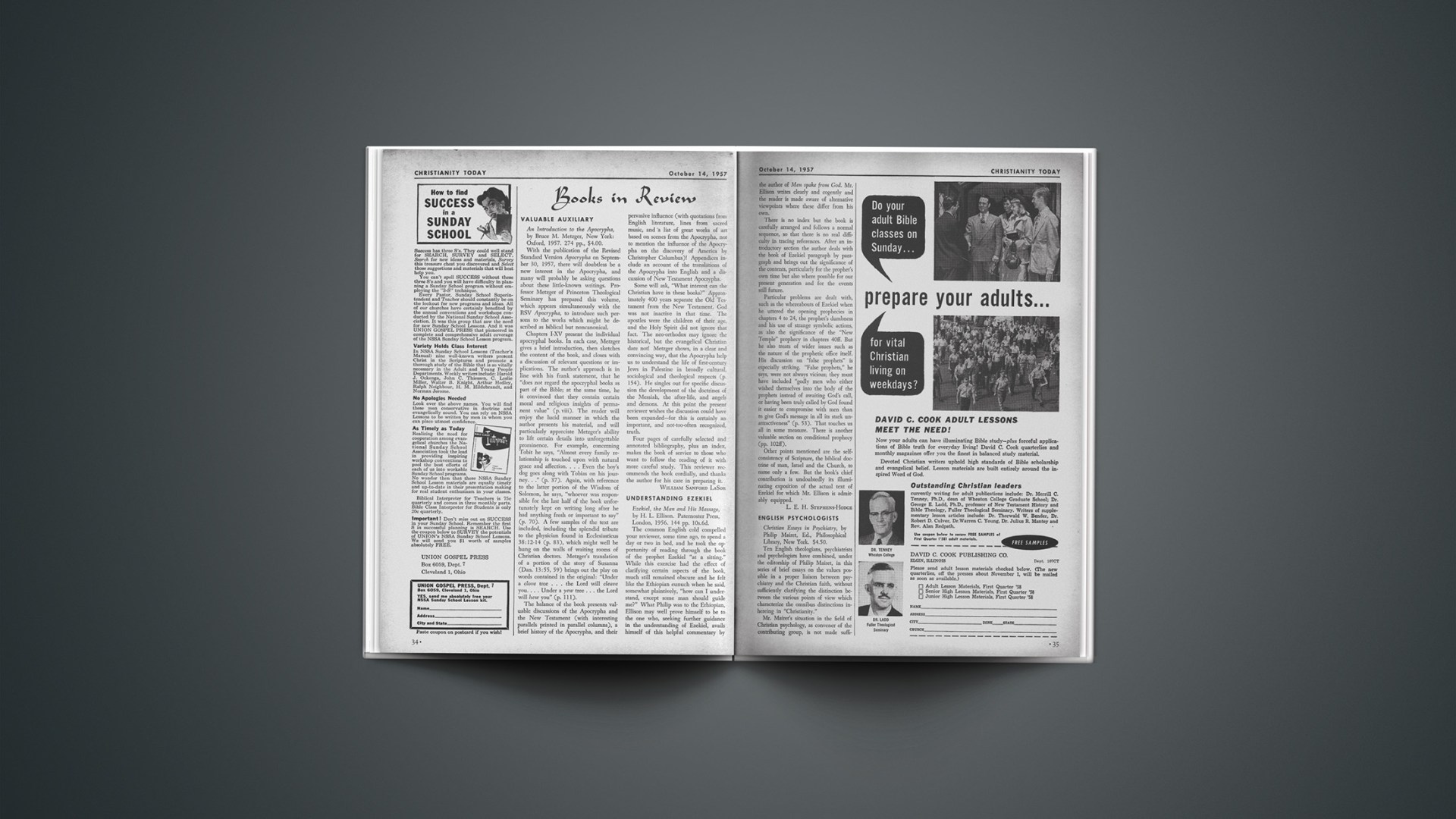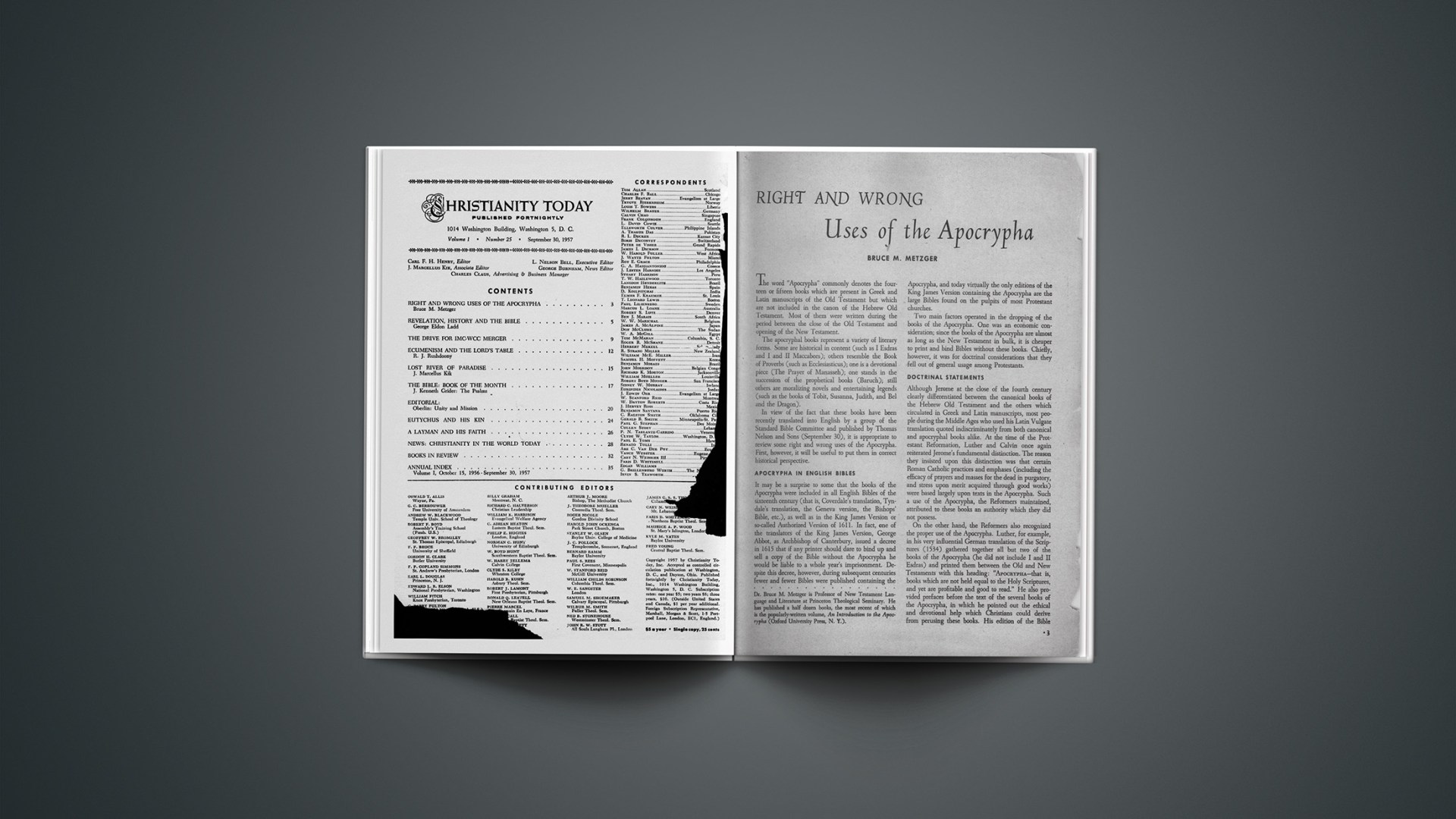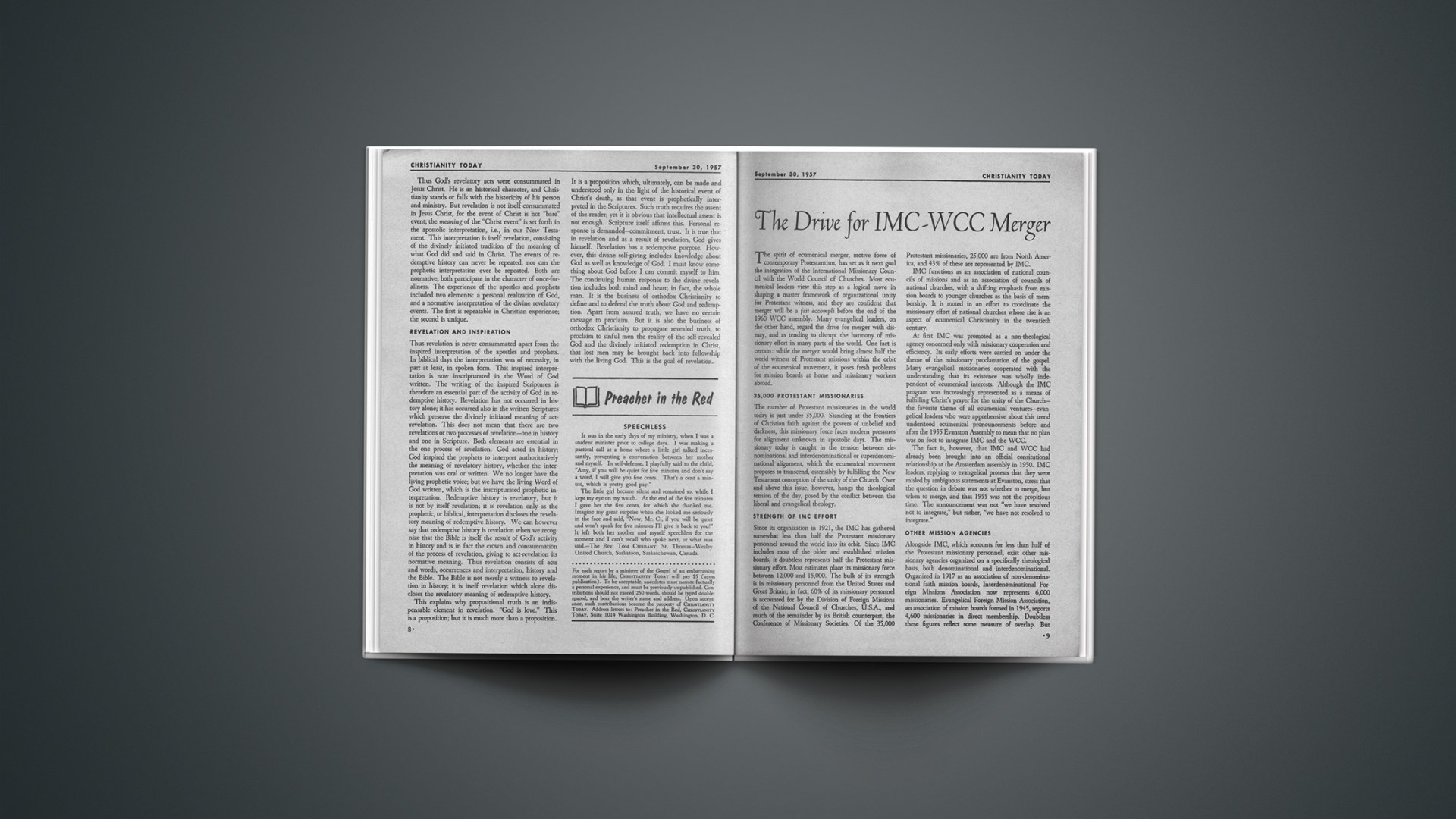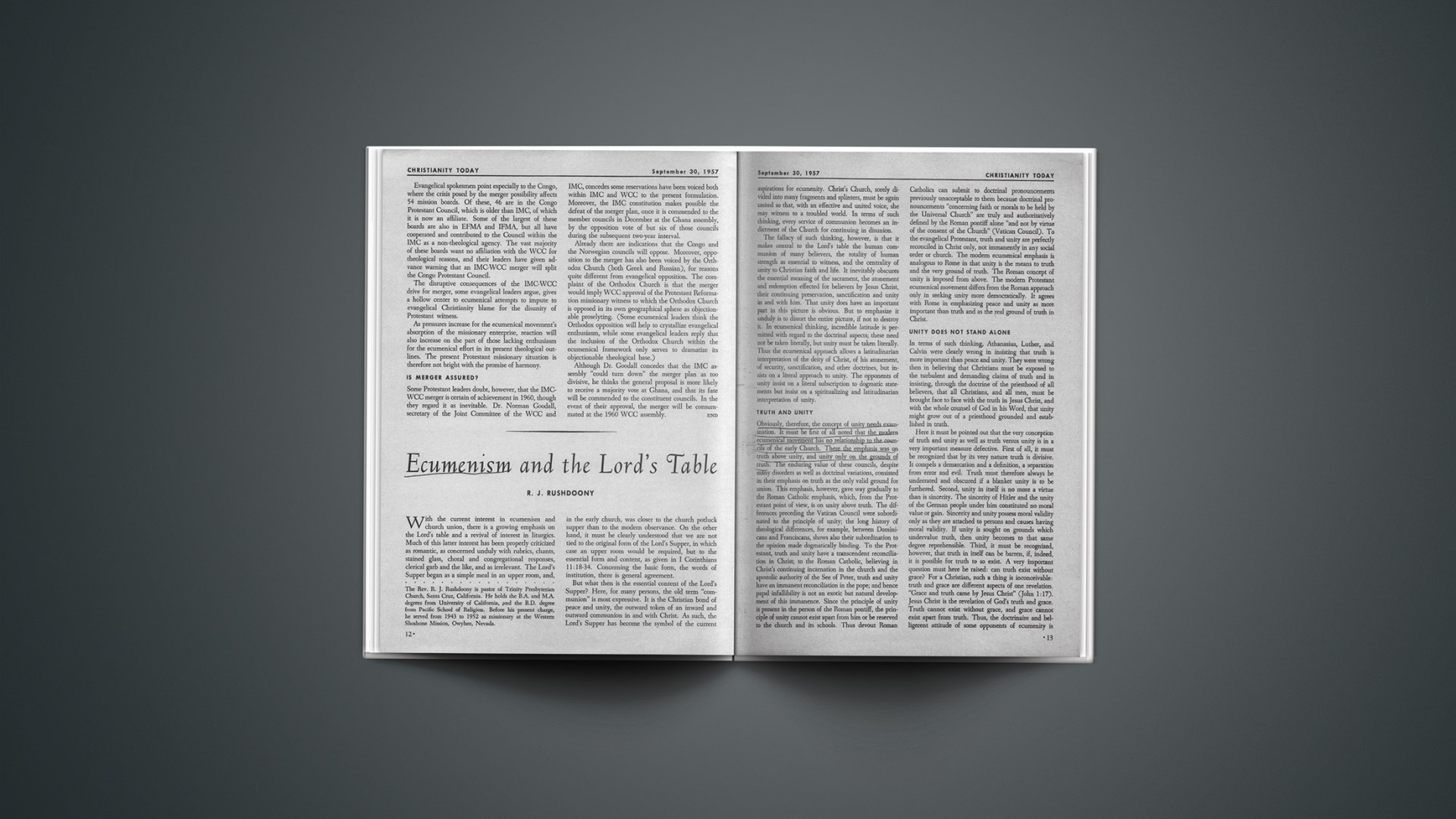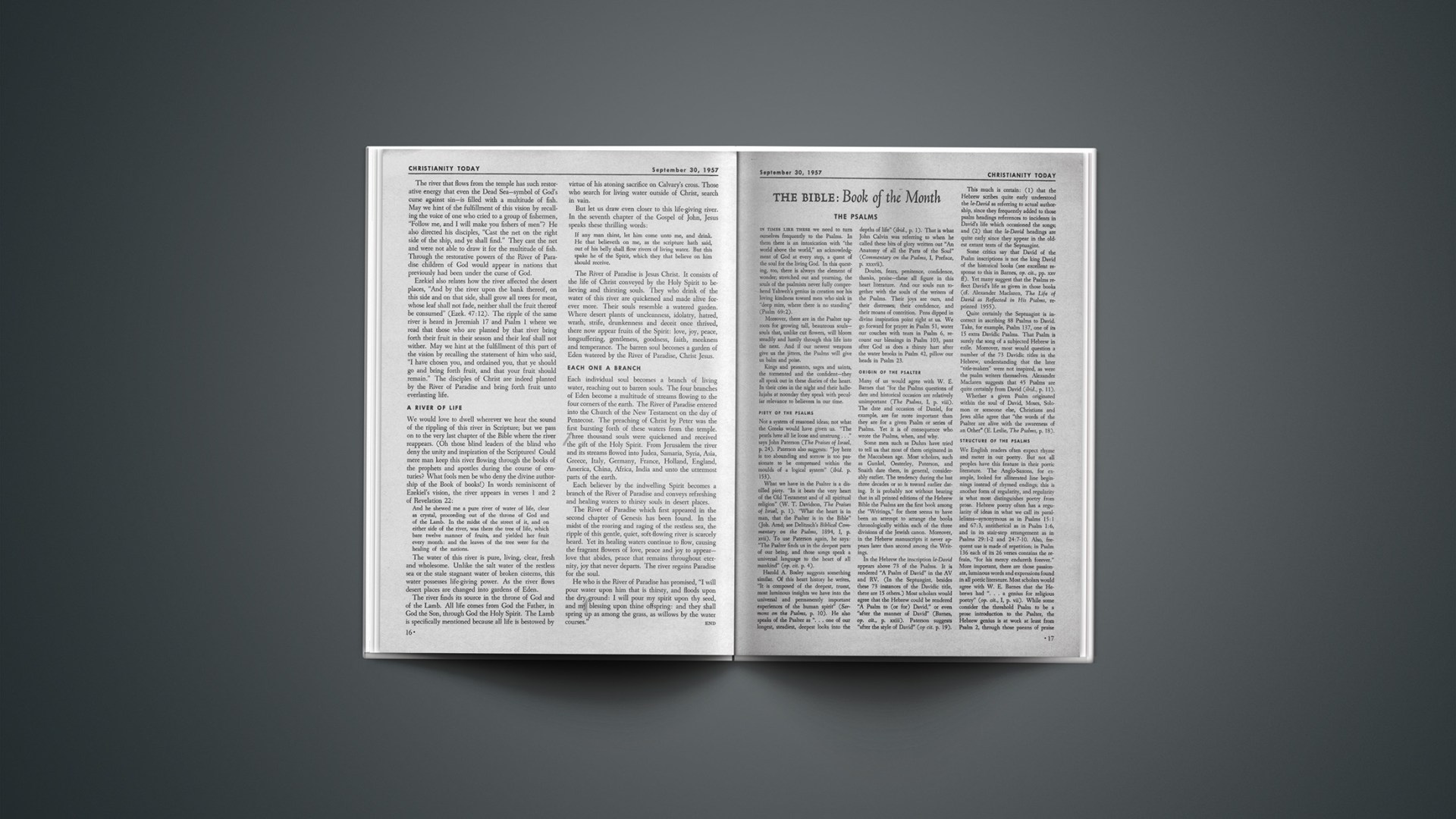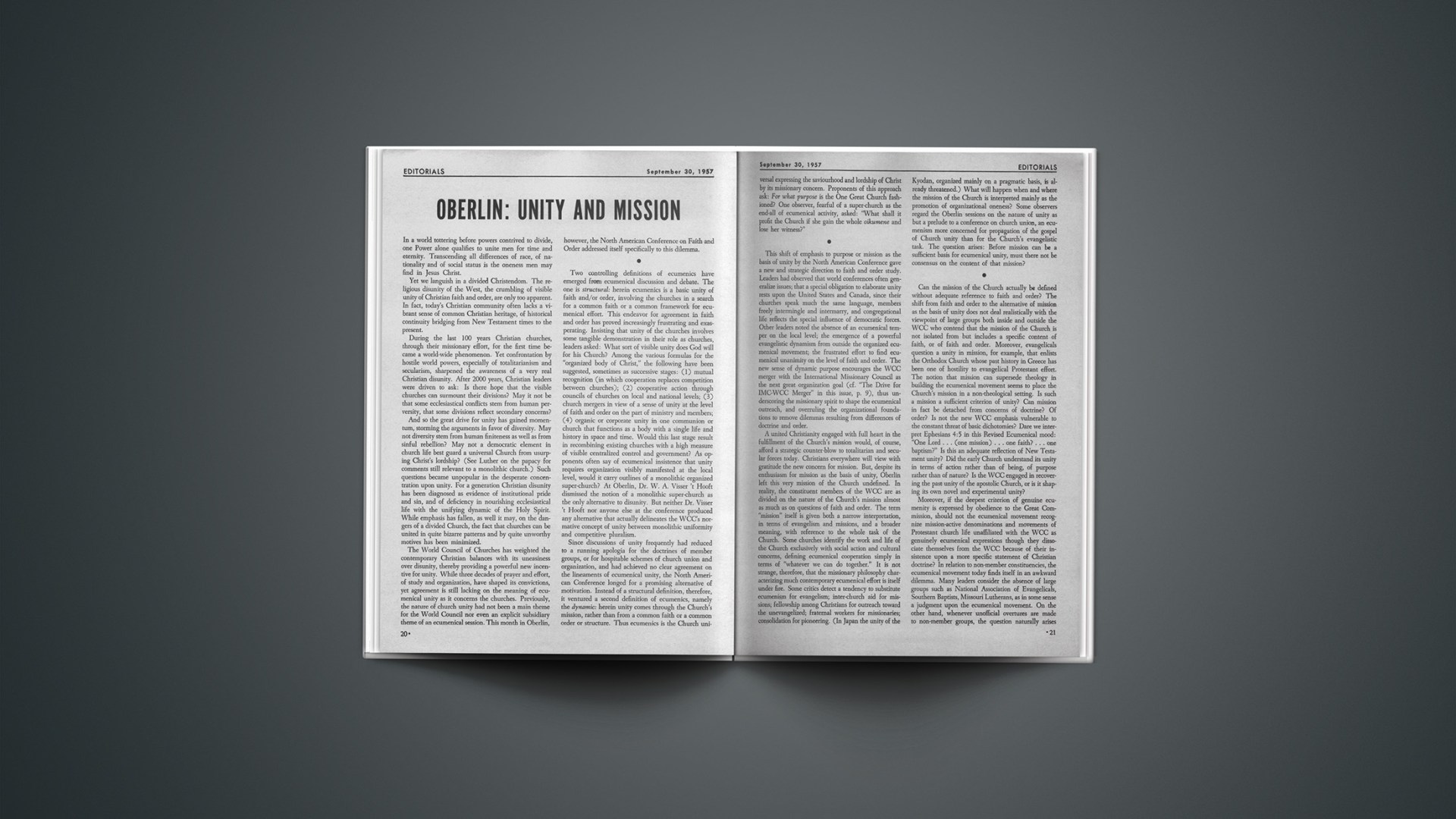NEWS
Christianity in the World Today
Marking a 15-year effort to frame an ecumenical movement on a creedal basis, National Association of Evangelicals observes NAE week, October 20–27. A fellowship and service organization, in a decade and a half the movement has gathered together scattered conservative groups, both denominations and churches, until it claims a membership of 2,000,000 and a service constituency of 10,000,000 evangelicals whose theological viewpoint is fundamental and conservative. Embraced in its cross section membership of conservative sympathies are groups ranging from Reformed Presbyterians, Free Will Baptists, Free Methodists and Wesleyan Methodists to Assemblies of God and Church of God, as well as several Mennonite, Friends and Pentecostal groups—altogether some 40 denominational bodies.
NAE leaders point out that their program has helped to give positive thrust and content to the evangelical center of American Protestantism; that it has helped to reverse the extreme fragmentation of the Protestant movement; that it has given the evangelical movement unity and voice it had lacked with the tendency of the Federal Council (later National Council of Churches) to liberal prospectives.
That their goal of a “united evangelicalism” is still far from achievement, NAE leaders readily admit. With 15 years’ pioneering and organizational effort behind, they disclose larger ambitions for the future, with a program of contact and enlistment of other religious and ecclesiastical bodies sharing the evangelical creedal viewpoint. To critics who complain that NAE represents a “least common denominator” in order to gather varying fundamentalist and evangelical groups into one basket, leaders exhibit their seven-point statement of faith, a requisite for NAE membership. (This includes belief in the Bible as the inspired, infallible, authoritative word of God; the eternal Trinity, the deity, virgin birth, sinlessness, miracles, vicarious and atoning death, the bodily resurrection, the ascension, and the second coming of the Lord Jesus Christ; salvation by regeneration of the Holy Spirit, and the present ministry of the Holy Spirit; final resurrection and judgment; and the spiritual unity of all believers in Christ.)
Spiritual unity is cited as evidence of genuine ecumenical approach founded on the creedal statements given, rather than on the basis of mere organization. In criticism from both the fundamentalist right and the liberal left, NAE leaders find evidence that they have followed a balanced course, freeing the evangelical movement from the stigma of extreme fundamentalistic abuses, and guarding it from liberal and neo-orthodox wanderings.
In reaching its influential role in American church life, NAE has relied heavily upon various service commissions and affilated agencies, which serve a constituency much larger than official NAE membership. Besides national headquarters in Wheaton, Ill., the movement operates a public affairs office in Washington, D. C., a publications office in Cincinnati, Ohio, and seven regional offices throughout the country. Related organizations are National Association of Christian Schools, Evangelical Foreign Missions Association, National Religious Broadcasters, Inc., National Sunday School Association, Evangelical Youth, Inc., and commissions on educational institutions, evangelism and church extension, government chaplaincies, international relations, a laymen’s council, a purchasing agency, a women’s fellowship, world relief, and a spiritual life commission. All these efforts have used NAE influence to enlarge the evangelical center of the Protestant scene. Evangelical Foreign Missions Association (EFMA), for instance, formed in 1945, now claims to represent about 5,000 missionaries around the world, supplying numerous services. Other agencies, like those for radio and education, operate on the same active service principle.
Many of the 147 evangelical leaders who signed the first official call for an organizing conference at St. Louis in 1942 are still active in NAE leadership and its affiliated organizations, including Dr. Harold J. Ockenga of Park Street Church, Boston, first president. The presidency today is held by Paul P. Petticord, head of Western Evangelical Theological Seminary, Portland, Oregon.
Dr. George L. Ford, Executive Director of NAE, in a comment on the 15th anniversary’s ecumenical significance, had this to say:
“The NAE is a major contribution to true ecumenicity for it has brought together the conservative evangelical denominations, organizations and churches not attracted by other interchurch movements. By avoiding the extremes, the NAE provides a positive witness by demonstrating the spiritual unity of believers in Christ in line with Christ’s prayer, ‘That they may be made perfect in one; and that the world may know that Thou has sent me and hast loved them, as Thou has loved me’ (John 17:23).
“The future of NAE lies in the strengthening of the positive spiritual witness of evangelicals in the world. This must include further expansion.… extension of service in other areas.… and encouragement of other truly evangelical denominations, churches and organizations to join in the spiritual witness.… NAE provides. The prospects for the work are now the brightest in the history of the organization.”
Churches in the NAE will mark Sunday, October 27, as NAE Sunday with special services and prayers.
Clean-Up Commission
First move in a nation-wide campaign against distribution and sale of pornographic literature has led in Washington, D. C., to formation of the Churchmen’s Commission for Decent Publications, supported from the outset by many denominational and interdenominational leaders.
Spurred to action by the multiplication of indecent and obscene publications, the commission caps a year’s preliminary effort by former Congressman O. K. Armstrong, prominent Baptist layman. Objectives are sixfold: Coordinating church, organizational and individual efforts to halt distribution and sale of indecent and obscene material; lifting standards of publication; encouraging literature expressive of the Judeo-Christian philosophy of sex morality; educating the public in the need for necessary federal, state and local laws; cooperating with local, state and national groups in law enforcement; assisting in the organization of effective regional groups.
Participants heard General Counsel Abe Goff of the U. S. Post Office department emphasize the importance of supportive community sentiment if postal authorities are to take effective injunctive action against “fake ‘art’ magazines and cheap ‘girlie’ magazines.” Goff pointed out that “while the main sale of such magazines is by newsstand, they acquire second class privileges (intended for educational and informational literature) for ‘an aura of respectibility.’ Mail carriers are then required at public expense to deliver corrupting material that most parents do not even want in their houses.”
Dr. Inman H. Douglass of the Christian Science Committee on Publications is national president. Others elected are Dr. A. C. Miller, of the Southern Baptist Christian Life Commission, first vice president; Dr. Fred E. Reissig, director of the Washington, D. C., Council of Churches, second vice president; Dr. Clyde W. Taylor, secretary of affairs of National Association of Evangelicals, secretary; Dr. Carl F. H. Henry, editor of CHRISTIANITY TODAY, treasurer. A national advisory council of 50 members is to be announced. Chairmen of standing committees are: membership, the Rev. Don Gill; research, the Rev. Ralph A. Cannon; legislation, Dr. O. K. Armstrong; public relations, Glenn D. Everett; finance, the Rev. Roger Burgess; community organization, the Rev. A. D. Zahnheiser.
Churchmen heard Mrs. C. R. Addington of the Women’s Club of Coral Gables tell how she successfully spearheaded a statewide effort for a law that “took 16 of the most objectionable magazines” off the Florida newsstands. “We had to overcome a natural reticence to identify ourselves with a task that sometimes had an indelicate and even unladylike aura,” she remarked, “but we found courage when we sensed that the sacredness of the home and of family life is at stake.”
Chaplain Wallace M. Hale, chief of the training division for Army chaplains, urged that cure as well as punishment be kept in view. “We must change the attitude of people and provide a new motivation and respect for moral law if we are really to lick the problem.” He noted “a more serious search for dependable absolutes, and somewhat less interest in the broad areas of personal freedom” in American life. “We must evolve a general code and principles that have the support of the citizenry, but we cannot stop there,” he said, “but must spell out the tested truths applicable to man’s personal righteousness.” Other speakers shared his hope that the commission’s social action effort not decline to a mere reliance upon legislation of morality.
People: Words And Events
Crusade Windup—Dr. Billy Graham and his team returned to the New York area for a series of suburban evangelistic rallies the week of Sept. 25 to October 1, with meetings also in New Jersey and Connecticut. On Reformation Sunday, Oct. 27, a great closing rally for the New York Crusade and the follow-up program will be held at the Polo Grounds. Dr. Graham will speak at the service at 3 p.m.
Far East Crusade—George Burnham, News Editor of CHRISTIANITY TODAY, is in the Far East during October, as part of the World Vision team holding pastors’ conferences and evangelistic crusades in Java, Singapore, The Philippines, Formosa, Japan, and Korea. The Seoul Crusade closes on October 20. Members of the campaign team are Dr. Bob Pierce, Dr. Richard Halverson, Dr. Paul Rees, Bishop Alexander Theophilus of India, The Rev. Jose Yap and Bishop Sobrepena of the Philippines, Dr. F. Carlton Booth, and Norman Nelson.
Seminary Adjustment—Concordia Theological Seminary of the Lutheran Church, Missouri Synod, opened the new academic year with approximately 550 students on campus. The liberal arts courses formerly taught at Concordia Seminary move this year to the new Concordia Senior College, Fort Wayne, Indiana. Thus, this year for the first time in its history, the seminary does not have an entering class. The revised curriculum will bring students to the seminary with a B.A. degree, and they will follow a four-year program (quarter system) of study, including one year of supervised practical work in a parish.
Spiritual Survey—A poll sponsored by the radio ministry of the North Syracuse Baptist Church, was conducted through the “Christ at Noon” exhibit at the New York State Fair. Motif of the booth was a huge question mark with the question, “Do You Have the Answer?” In response to the question, “Do you believe that there is a personal God?” 1763 replied yes, 81 no, 48 uncertain. To other questions, responses were: “Do you believe that the Bible is God’s message to man?”—1739 yes, 40 no, 29 uncertain. “Do you believe that Jesus Christ is the Son of God?” 1737 yes, 32 no, 37 uncertain. Do you believe that Jesus Christ died for your sins, rose again, and lives to be your personal Lord and Saviour?”—1757 yes, 36 no, 56 uncertain. Do you believe that you will go to heaven when you die?”—1183 yes, 76 no, 584 uncertain.
Lutheran Membership—A total membership in the Lutheran Churches of the United States and Canada increased to 7,618,000 in 1956, according to the National Lutheran Council. This was an increase of 3.3 percent which has been about the average yearly gain for the last ten years. The Lutherans represent the third largest Protestant denominational group in America, exceeded only by Baptists and Methodists. Largest single body of the Lutheran Church-Missouri Synod, now numbering 2,152,000.
Accrediting Post—The Rev. Jared F. Gerig, president of the Missionary Church Association, has been named president of Fort Wayne Bible College, effective January 1, 1958, when he will succeed Dr. S. A. Witmer. Dr. Witmer will become executive secretary of the Accrediting Association of Bible Institutes and Bible Colleges.
Christian School Growth—Some 37,000 pupils are now enrolled in 137 day schools affiliated with the National Union of Christian Schools, it was reported at the group’s annual convention. John A. Vander Ark, director of the union, said the schools, sponsored chiefly by members of the Christian Reformed Church, are growing at the rate of 2,000 students a year. Ten new schools were developed each year during the last three years.
Baptist Brotherhood—More than 6,000 Baptist laymen from 40 states met recently in Oklahoma City at the First National Conference of Southern Baptist Men. The three-day conclave featured addresses and discussions on the theme, “Free Men Through the Ages.”
Wesley Hymn Sing—Hymn festivals to celebrate the 250th anniversary of Charles Wesley’s birth are being planned by Methodist churches throughout the country in December, as part of a worldwide Charles Wesley celebration, sponsored by the World Methodist Council. Charles was one of the greatest hymn writers in history and his brother John Wesley was the founder of Methodism.
Artist Honored
Warner Sallman, Chicago artist whose “Head of Christ” and other religious paintings are known the world over, was honored at a dinner in Washington on October 3, when he was presented the Upper Room award for world Christian fellowship. The award cited Sallman’s artistic leadership in “helping bridge the gap between denominations and bringing them closer in Christian fellowship.”
We Quote:
JOSEPH SITTLER
Professor, Federated Theological Faculty, University of Chicago
Enquiry into the nature of Christian worship of God has, particularly in North America, got to operate in a sphere of discourse already occupied. The name of the occupant, in very many of our congregations, is the psychology of worship. This strange roomer got into and established himself in the living room of church practice in roughly the following way: that people do worship God is an observable fact; and every fact is permeable to psychological enquiry. Psychology does not operate from hand to mouth; it has either open or unavowed presuppositions about the structure and dynamics of the psyche. If, then, in worship people are in some way or other in search of a relationship to the ineffable there must be ways which lubricate and ways which hinder this search. The human animal is influenced by setting, accompaniment, symbols, silence, the gravity of statement and response, the solidarity-producing impact of solemn music, etc. So it has happened that experts in worship have arisen among us. All assume that the purpose of public worship is to create a mood; and he is the most admirable as the leader of worship who has mastered finesse in the mood-setting devices made available by the application of psychological categories. Thence has flowed that considerable and melancholy river of counsel whereby one may learn how to organize an assault upon the cognitive and critical faculties of the mind, how to anesthetize into easy access the non-verbalized but dependable anxieties that roam about in the solitary and collective unconscious, and how to conduct a brain-washing under the presumed banner of the Holy Ghost.
That this is what worship means in thousands of congregations is certainly true; it is equally true that the Scriptures know nothing about such ideas. Where we are enjoined to be still and know that God is God, the presupposition is not that stillness is good and speech is bad—but rather that God is prior to man and all God-man relationships are out of joint if that is not acknowledged.—In an address on “The Shape of the Church’s Response in Worship,” North American Conference on Faith and Order, Sept. 6, 1957.
WALTER G. MUELDER
Dean, Boston University School of Theology
Another group of problems have to do with bureaucracy, or, as some prefer to say, the administrative top. The role of bureaucracy in churches is analogous to that in all institutions. Church bureaucrats dominate ecumenical discussions. Bureaucracy maximizes vocational security and promotes technical efficiency. Tenure, pensions, incremental salaries, regularized procedure for promotion are related to leadership control. Control, continuity, administrative discretion and rational order make for institutional efficiency. However, bureaucracy tends to separate the average member, the so-called layman, from the expert who holds the position of legitimate administrative authority.… [especially] when the ecclesiastical bureaucrat is also an ordained clergyman. Ecumenicity, the bureaucrat may forget, is a function of the whole church—not of its clerical and administrative top alone.
Though bureaucracy makes for rational efficiency and institutional security, it also tends to develop certain dysfunctions, such as: blindness to needed change; trained incapacity to sense new needs; inflexibility in applying skills and resources to changing conditions … etc. These dysfunctions are no respecters of denominational polities and apply to boards and agencies as well as to fundamental church structure.
The consequence of these dysfunctions is that the discipline once designed to assist efficiency becomes an intrinsic value, and loyalty to ultimate ideals on the part of subordinates is measured by obedience to superiors in the hierarchy of the institution. Bureaucracy thus breeds overconformity.—In an address on “Institutionalism in Relation to Unity and Disunity” at the World Council of Churches’ North American Faith and Order Conference.
Ministers Hear Graham
Fifteen hundred twenty-five New York ministers and friends gathered at 8:30 a.m. on September 24 to hear Billy Graham assess the New York Campaign. Optimism and gratitude pervaded the atmosphere as ministers greeted one another in New York’s largest ballroom, taxing its faciilties, interspersing their remarks with praise to the Lord for the great victory won.
The speakers’ table was occupied by the Graham team and the members of the Protestant Council of New York. Dr. Jesse M. Bader, for 27 years Secretary of the Department of Evangelism for the Federal Council of Churches, gave a ringing challenge to the ministers and recognized the two divisions of the campaign: First, the Crusade as held in Madison Square Garden; second, the personal visitation campaign scheduled October 20 to 27 in at least a thousand communities by teams of laymen under the direction of ministers from a thousand cooperating churches.
Dr. Bader declared that evangelism is an imperative, not an elective of the Church. He admonished that what Christ made primary the Church must not make secondary. His address gave ringing affirmation of the biblical program and basis for evangelism and a challenging appeal for participation. The personal calling campaign is to have the same purpose as the public Crusade, namely to win men to Jesus Christ, to reach out further, and to bring men to commitment to Christ. Dr. Bader declared that this could not be done unless the ministers were thoroughly committed to it. The ministers are the key men in the churches. If they are evangelistic, the people will be evangelistic. Hence, the success or failure of this undertaking rests with the ministers.
Preparation must be made for this campaign by sermons from the pulpit, prayer meetings of the people, advertising, gathering a prospect list, selecting workers, and beaming the whole church program to visitation evangelism. Thirty-five selected men representing different denominations will be assigned to as many districts. These selected men will meet with the ministers of each district from Monday until Friday, from 10:30 a.m. until 12:00 daily. They will spark the program and bring information which the pastors are to bring to their own people each night at the supper meeting before calling commences. Ministers were assured that if this is successful in New York it will be added to the Graham program of evangelism in every city the team visits.
Roger Hull, general chairman of the campaign, spoke briefly his appreciation of his privileged place of leadership, voicing thanksgiving to God. Beverly Shea, in his inimitable way, sang “I Know a Name.” Then Billy Graham spoke.
Dr. Graham expressed appreciation for all who came to this morning meeting, for their faithfulness, their energy expended and their cooperation. He pointed out that it was not properly called a Billy Graham campaign, for thousands participated by prayer, giving counseling, attending and advertising the meetings. Billy paid tribute to Dan Potter, Secretary of the Protestant Council, for unflagging faithfulness and enthusiasm, to all cooperating organizations, and to the unusual and sustained coop eration of the churches.
Graham then launched into his major address. He spoke of things that he had learned in the campaign.
The power of prayer. He acknowledged records of organized prayer meetings in 109 countries throughout the world. Persons like Madame Chiang Kai-shek organized prayer meetings sustained during the entire campaign. On Formosa all-night prayer meetings were held. On the farthest mission fields missionaries and native Christians were praying. He paid particular tribute to Mrs. Norman Vincent Peale who organized the prayer meetings among the women in New York City.
The power of faith. Graham paid tribute to the faith of members of the executive committees such as Ralph Nesbitt, John Sutherland Bonnell, John Wimbish, Erling C. Olsen and others. Their faith went beyond his and was justified in the results.
The power and authority of the Scriptures. He emphasized that the source of power in his preaching was a return to the Book which in his hand became as a flame of fire or as a hammer, according to the words of Jeremiah. Many people were converted by verses of Scripture which stuck in their minds after all else was forgotten. Writing their testimony they told of the power of the Scripture.
The influence of the Holy Spirit, who was there in a demonstration of power to convict, to reprove and to convert.
The power of Christ to change lives. Here Graham quoted numerous illustrations which were given to him from the testimonies received by individuals who were converted. Most effective of all was the influence of the television as a result of which over a million letters came in containing requests from hundreds of thousands of people for spiritual help. Some pastors had additions to their membership immediately after the television programs and others reported definite conversions.
Next, he emphasized that the harvest is ripe in New York City. Now is the time to reap for if we fail to reap at this moment, we may never get another opportunity. The tide of revival moves in and out and the tide is in just now in New York City. If the pastors utilize this, they hold in their hands the key to peace in the world. Ministers simply cannot go back to the same way of life. They have been shaken out of the old ruts and must not get back in them again.
Lastly, Graham emphasized that any large movement such as this Crusade would necessarily have its critics. Then he dealt individually with the criticisms which had come, none of which he treated as personal. He explained the necessity for statistics and great expenditures. He showed that 18 per cent of those responding with decisions had not been identified with any church and 30 per cent to 40 per cent were of people who did not attend church regularly. Graham also pointed out that it is not the province of an evangelist to deal with all the deep and profound problems related to Christianity. He humbly confessed that probably all would not agree with his theology, and that in some areas he might not be right, but that he stood upon the Bible.
H.J.O.
Goal For 1958
A goal of 475,000 converts for 1958 and a day of commitment to soul wining were announced by Dr. Leonard Sanderson, Secretary of Evangelism for the Home Mission Board of the Southern Baptist Convention.
The day of commitment will be Sunday, January 5, 1958. At that time members of 30,384 churches will be asked to sign cards pledging a personal attempt “to win non-Christians to Christ during the year.”
Hawaiian Lad
“Awaken ye islands of the far away sea!”
This prayer of a young Hawaiian who lived over 140 years ago was the theme of the annual meeting in Hilo of the 113 Congregational Christian Churches of the Territory of Hawaii.
Henry Opukahaia was remembered and honored as the lad who was responsible for the beginning of the mission story in Hawaii. In 1808, Opukahaia sailed for America. Here he was converted to Christianity. He died in 1818 in Cornwall, Conn., but not before he had impressed upon the officials of the American Board of Commissioners for Foreign Missions his people’s need.
After being commissioned in the famous Park Street Church of Boston, the first little band of missionaries sailed for Hawaii in 1819.
A highlight of the program this year was a pilgrimage to Opukahaia’s birthplace for the dedication of a memorial chapel.
An editorial in the Hilo-Tribune Herald entitled Tribute to Opukahaia said … he was instrumental in bequeathing to the islands a new and perpetual life, one that is constantly being marked by people of all races in a peaceful Hawaii.” The annual meeting also marked the 100th anniversary of the sailing of the Morning Star, first missionary ship to arrive in the islands to the south of the Hawaiian chain, the Micronesian Islands. In true New Testament fashion, the islanders of Hawaii, after hearing of Christ and his love went to the southern islands as missionaries.
Today, a new Morning Star carries Christian workers between the islands. This is the seventh one since the Micronesians first were told of Christ. The ship now in service is skippered by Miss Eleanor Wilson, an ABCFM missionary. Part of her support comes from the same historic Park Street Church in Boston.
The Hawaiian Evangelical Association of Congregational Christian Churches announced plans of a $1.5 million project for next year which will involve new buildings for the denomination’s headquarters. Plans call for a memorial building with a 600-seat auditorium, headquarters offices and offices for rent.
The session closed with the annual Festival of Choirs in which groups from the churches across the territory presented the great music for which the Hawaiian church is known. In 1958 the meeting will be held on Kauai Island.
Germany
Baptists In Germany
The first civilian American Baptist church in Germany has been organized at Kaiserlautern, with the Rev. Donald Scott McAlpine, formerly of New York and Washington, D. C., as pastor. Members of four U. S. Baptist conventions are presented in the membership, and services are in English.
New Zealand
Union Of Churches
A joint standing committee in New Zealand has issued a report in which the vote of four church groups favors the “principle” of union.
In the major body, the Presbyterian Church (76,005 members) voted three to one in favor of union, but one-third of the total membership did not vote.
The total and union vote percentage were heavier in other churches. In the Methodist church (28,679 members) 92 per cent of those voting favored union. The affirmative vote among Congregational churches and the Associated Churches of Christ were 88 and 94 per cent, respectively.
The matter now will go to the annual assemblies or conferences, meeting later in the year, to decide what steps, if any, should be taken as a result of the preliminary voting.
—R.S.M.



